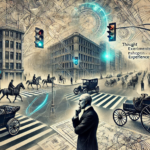
The simple answer: It depends.
The better answer: Not always, but when we must, we need to be obsessively intentional about how we bridge that gap.
1. Experience is the Gold Standard—But Not Always Possible
When designing for an experience, living it will always give you insight that observation alone cannot. A chef understands food differently than a food scientist. A teacher understands the classroom differently than an education policy maker. A woman designing feminine products understands needs in a way a man never could.
But what happens when direct experience isn’t possible?
- Men can’t experience menstruation.
- Most of us won’t experience disabilities we design for.
- Einstein never traveled at the speed of light, but he still cracked relativity.
This is where thought experiments, radical empathy, and deep observation come into play.
2. The Thought Experiment as a Design Tool
A thought experiment isn’t just “thinking really hard about a problem.” It’s a structured way of mentally walking through an experience—identifying constraints, testing ideas, and simulating reality as closely as possible.
🔹 How do we do this well?
- Ask, don’t assume. The best thought experiments start with questions, not conclusions.
- Observe relentlessly. What do people struggle with? Where do they hesitate?
- Engage those with experience. Thought experiments should be informed by real-world data, feedback, and lived experience.
- Test assumptions. Where might we be wrong? How can we verify our theories?
A great thought experiment should feel like you’re living inside the problem, even if you never will in real life.
3. The Danger of Designing From a Distance
Where this breaks down is when we mistake a thought experiment for lived reality.
This is the trap policymakers often fall into—solving problems with broad strokes, without truly understanding the conditions on the ground. It’s how we end up with:
❌ Corporate wellness programs designed by executives who never experience burnout.
❌ Education reform designed by people who have never taught.
❌ Accessibility features designed without disabled users in the room.
Thought experiments can never replace the voices of those who experience a problem firsthand. But they can make us more effective at listening, asking better questions, and designing with more clarity.
4. What This Is Not
This isn’t about remote vs. in-person work.
This isn’t about “butts in seats” or surveillance culture.
This isn’t about invalidating expertise that comes from experience.
This is about making sure that when we can’t live the experience, we don’t design in a vacuum. Instead, we should:
✅ Get as close to the experience as possible—through research, immersion, and direct feedback.
✅ Use thought experiments to sharpen our intuition—but not to replace real-world input.
✅ Balance first-hand knowledge with broad perspective—leveraging the strengths of both.
5. The Continuum: Bridging Experience and Thought
We don’t need a binary stance on this. We need a nuanced approach that recognizes when experience is essential, when thought experiments can fill the gap, and when we need both.
Think of it as a continuum:
| Lived Experience | Hybrid (Experience + Thought Experiments) | Pure Thought Experiments |
|---|---|---|
| A chef designing a new dish | An astronaut trainer simulating zero gravity | Einstein predicting relativity |
| A mother designing baby products | A UX designer shadowing users | Scientists theorizing black holes |
| A teacher redesigning a curriculum | A product designer observing customers | Sci-fi authors predicting tech |
Every situation calls for a different approach—but the best solutions almost always involve both lived experience and structured thought experiments.
6. The Challenge: How Can We Design Like Eno?
William Phelps Eno never drove a car, but he changed the way billions of people drive every day.
He didn’t rely on personal experience. He relied on:
🚦 Observation—watching traffic patterns, seeing where things broke down.
🚦 Systems thinking—designing rules that worked at scale.
🚦 Testing and iteration—implementing, analyzing, and refining.
If we want to design as effectively as he did—whether in UX, product development, policy, or any field—we need to master the balance between lived experience and thought experiments.
🔹 When can we experience something firsthand? We should.
🔹 When we can’t, how do we get as close as possible?
🔹 Who can we collaborate with to fill in the gaps?
🔹 How do we rigorously test our ideas before assuming they work?
Final Thought: The Designer’s Dilemma
We may never experience everything we design for.
But we can learn how to see through the eyes of others.
We can build systems that remove friction and failure.
We can listen, observe, and test until we get it right.
And maybe—just maybe—we can design something that, like Eno’s work, stands the test of time.
This reflection is part of The Deductionists’ ongoing investigation.
🎙 Hear more irreverent insights on The Deductionists Podcast—available on Spotify, Apple Podcasts, and anywhere you get your podcasts.
🔗 Listen now:
👉 Apple Podcasts
👉 Spotify
📩 Subscribe to the Newsletter on LinkedIn: The Deductionists Newsletter.